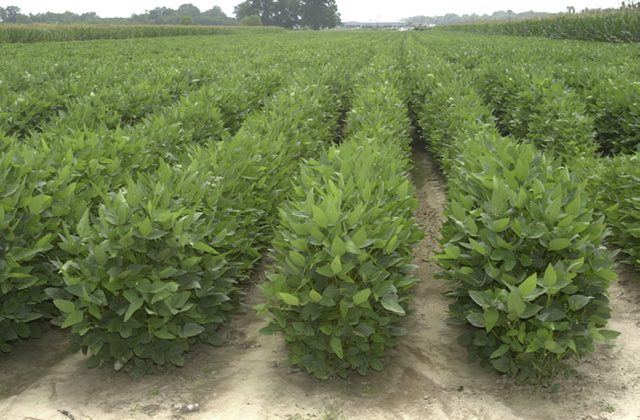Nitrogen in Mississippi Soils
Nitrogen is essential for plant growth. It is the mineral that plants require most. Lack of nitrogen in a plant may be seen on older leaves that are mostly pale green or yellow.

Field crops typically require more nitrogen (N) than Mississippi soils provide in a growing season. Fertilizer or manure sources of nitrogen must be added for economical crop production. However, too much available nitrogen may lower yields and lessen crop quality. If the soil nitrogen as nitrate (NO3-) supply is greater than crop demand, the excess nitrate may enter ground or surface water.
Nitrogen behavior is complex, but farmers must understand it so they can manage it for the greatest profit and least adverse effect on the environment.
Sources of Nitrogen in the Environment
Nitrogen is in the air, water, soil, and biological materials of the earth. The air contains large quantities of dinitrogen (N2) gas, but it is not directly available to plants. Of the almost 37,000 tons of atmospheric nitrogen directly above each acre of land, about 5 pounds of nitrogen per acre are deposited with rain or snow each year. The small amount that falls is from lightning and burning processes, including automobile emissions. Even though the amount added by direct deposition is small, most nitrogen used by crops originates in the atmosphere and is retrieved by industrial or biological processes.
The amount of nitrogen in soils is closely associated with organic matter levels. Legumes such as soybeans and alfalfa change atmospheric dinitrogen to plant-available forms by way of a process involving Rhizobium bacteria and the plant roots. This “fixed” nitrogen may either return to the soil to become part of soil organic matter and serve as a nitrogen source to later crops or be removed in harvested plant materials.
Small quantities of soil nitrogen are provided by residue from plants that do not fix atmospheric nitrogen. Organic matter in Mississippi soils typically ranges from 0.5 percent to 2 percent by weight of the upper 6 inches. Organic matter is normally about 5 percent nitrogen, so total nitrogen in the topsoil ranges from 500 pounds per acre to 2,000 pounds per acre. However, only a very small portion of the total nitrogen is available to plants during a growing season. Organic matter is replenished by returning crop residues to the soil or introducing other organic sources such as manures or animal bedding.
Almost all nitrogen in commercially available fertilizers is derived by combining atmospheric dinitrogen with dihydrogen (H2) to form anhydrous ammonia (NH3), which may be used directly as fertilizer or as a starting point in manufacturing of other nitrogen fertilizers.
Even though anhydrous ammonia is an efficient source of fertilizer nitrogen, it must be stored under high pressure; therefore, it requires special handling and stringent safety precautions. These requirements have made other nitrogen fertilizers more popular.
Animal manures are also important sources of nitrogen in the environment. The quantity of nitrogen in the manure depends on the animal’s species, age, diet, and bedding materials. Manure begins contributing to plant nutrition and soil organic matter when added to agricultural soils, but not all the nitrogen within manure is immediately available to plants.
Forms of Nitrogen in Soils
Nitrogen is in both organic and inorganic forms in soils. More than 90 percent of soil nitrogen is associated with soil organic matter. Nitrogen is in compounds identifiable as part of the original organic material such as proteins, amino acids, or amino sugars, or in very complex unidentified substances in advanced stages of decomposition. These uncharacterized substances resist further microbial degradation and account for the very slow availability of soil nitrogen.
Plants may use either ammonium (NH4+) or nitrate, which behave quite differently in soils. Positively charged ammonium is attracted to negatively charged sites on soil particles, as are other cations. It is available to plants, but it will not leach.
Negatively charged nitrate remains in the soil solution and moves with soil water. Nitrate may leach out of the root zone when rainfall is excessive, or it may accumulate at the soil surface in dry weather.
Nitrogen Transformations in Soils
Nitrogen transformations depend on soil moisture conditions, soil acidity, temperature, and microbial activity. Because the Mississippi climate is characteristically warm and humid, microbial transformations occur throughout most of the year. This extended period of decomposition results in lower organic matter levels in Mississippi soils than in cooler, drier climates.
Ammonium can be adsorbed in soil particles or taken up by plants without transformation, but in most cases, it is converted to nitrate soon after its formation or addition as fertilizer. This process, called nitrification, involves two groups of soil bacteria. First, Nitrosomas bacteria produce nitrite (NO2-). Nitrobacter species then convert nitrite to nitrate soon after its formation.
Two things to note: 1) ammonium may exist in soils only a short time, and 2) hydron (H+) ions are produced, which increases soil acidity or lowers the soil pH. This conversion may be slowed by commercially available nitrification inhibitors that maintain nitrogen in the ammonium longer.
Mineralization is the process of converting organic nitrogen to plant-available inorganic forms. It is a gradual breaking down of large organic molecules to smaller molecules by soil microorganisms. After these microbes complete their relatively brief life cycles, they are decomposed by other microbes. Energy for this process comes from carbon (C) in the material being used, so introduction of fresh plant materials rich in decomposable carbon stimulates this process.
Immobilization occurs when plants and soil microorganisms incorporate inorganic nitrogen into an organic nitrogen form. Because this process depends largely on microbes, the availability of carbon and other nutrients determines the rate of immobilization. When residues with high C:N ratios are being decomposed, all readily available nitrogen within the soil system may be used by the microbes and unavailable for plant uptake.
This effect is temporary. Eventually some of the microbial population dies and decomposes, releasing nitrogen that is available to plants. The risk of immobilization is avoided by mixing plant residue into the soil well before the next cropping cycle.
Loss of Nitrogen from Soils
Even though soil nitrogen may not be available to plants through immobilization, it is still in the soil. Nitrogen can be permanently removed from soil by erosion, leaching, denitrification, or volatilization.
Organic matter, which contains most native nitrogen, is concentrated in the plow layer of soils, making it susceptible to loss by erosion. Soil conservation practices lessen erosion loss.
Leaching loss occurs when nitrate remains in the soil water and moves away from root uptake areas with downward water movement. This nitrogen loss is a contaminant if it reaches ground or surface waters. Nitrogen leaching is more likely when there is more rain than a crop can use.
A major mechanism of nitrogen loss in Mississippi is denitrification in waterlogged soils. As the water content of soils increases, the amount of air in soils decreases. Some soil microorganisms can use the oxygen in soil nitrate and nitrite instead of gaseous dioxygen (O2). Ultimately, nitrous oxide gases (N2, NO, and N2O) are produced and released into the atmosphere, resulting in a loss of nitrogen from the soil.
Conditions necessary for denitrification are waterlogged soils, carbon sources (from organic matter or plant residues) for use by the anaerobic microbes, and nitrogen as either nitrate or nitrite. The rate is greatly accelerated by higher temperatures.
The loss of volatile ammonia gas (NH3) to the atmosphere can also occur from anhydrous, urea, or nitrogen solution fertilizer sources. Losses by volatilization are minimized through proper management of fertilizer applications. Producers should apply anhydrous ammonia when soil conditions allow good sealing of the applicator slit after fertilization. See Table 1 for a list of common nitrogen fertilizers.
The first step in converting urea nitrogen to ammonium is the production of ammonia. Volatile losses from urea are more likely with warm temperatures (>50°), high pH soils (>7), pastures, and conservation tillage with high residues.
Ideally, you should incorporate urea into the soil or apply it before a rainfall. Since urea volatilization is increased when broadcast-applied to vegetative cover or plant residue, you must be careful when using urea as a topdressing nitrogen source. You should never place urea in contact with seed because of the toxic effects of ammonia on seedlings. The same precautions apply to nitrogen solutions since they contain urea.
Using Nitrogen Effectively
The frequent changes of nitrogen in soils limits the value of nitrogen soil testing as a predictive tool in Mississippi’s warm, humid climate. While supplemental nitrogen fertilization is usually necessary for economic production of nonlegume crops, large nitrogen applications cannot substitute for poor management. Research-based economic and environmentally friendly recommendations are available for all crops produced in Mississippi.
|
Fertilizer |
Nitrogen % |
Phosphate % |
Potash % |
|
Ammonium nitrate |
33.5–34 |
0 |
0 |
|
Ammonium sulfate |
21 |
0 |
0 |
|
Anhydrous ammonia |
82 |
0 |
0 |
|
Aqua ammonia |
20 |
0 |
0 |
|
Calcium nitrate |
16 |
0 |
0 |
|
Sodium nitrate |
16 |
0 |
0 |
|
Urea |
45–46 |
0 |
0 |
|
Urea ammonium nitrate |
28–32 |
0 |
0 (solution) |
Best Management Practices for Nitrogen Fertilizers
- Use realistic yield goals.
- Use the most suitable nitrogen fertilizer source, depending on the crop, application method, and climatic conditions.
- Use proper application techniques, including variable rate technology if appropriate for the situation.
- Maintain and calibrate application equipment.
- Avoid application to surface waters.
- Time application properly for the crop.
- Control soil erosion.
- Properly control water flow.
- Use cover crops and maintain crop residue on the soil surface.
- Credit legume crop contribution to soil nitrogen when appropriate.
The information given here is for educational purposes only. References to commercial products, trade names, or suppliers are made with the understanding that no endorsement is implied and that no discrimination against other products or suppliers is intended.
Publication 3964 (POD-12-23)
Reviewed by Corey Bryant, PhD, Assistant Professor, Delta Research and Extension Center, from an earlier version by Larry Oldham, PhD, Extension Professor (retired), Plant and Soil Sciences.
The Mississippi State University Extension Service is working to ensure all web content is accessible to all users. If you need assistance accessing any of our content, please email the webteam or call 662-325-2262.







